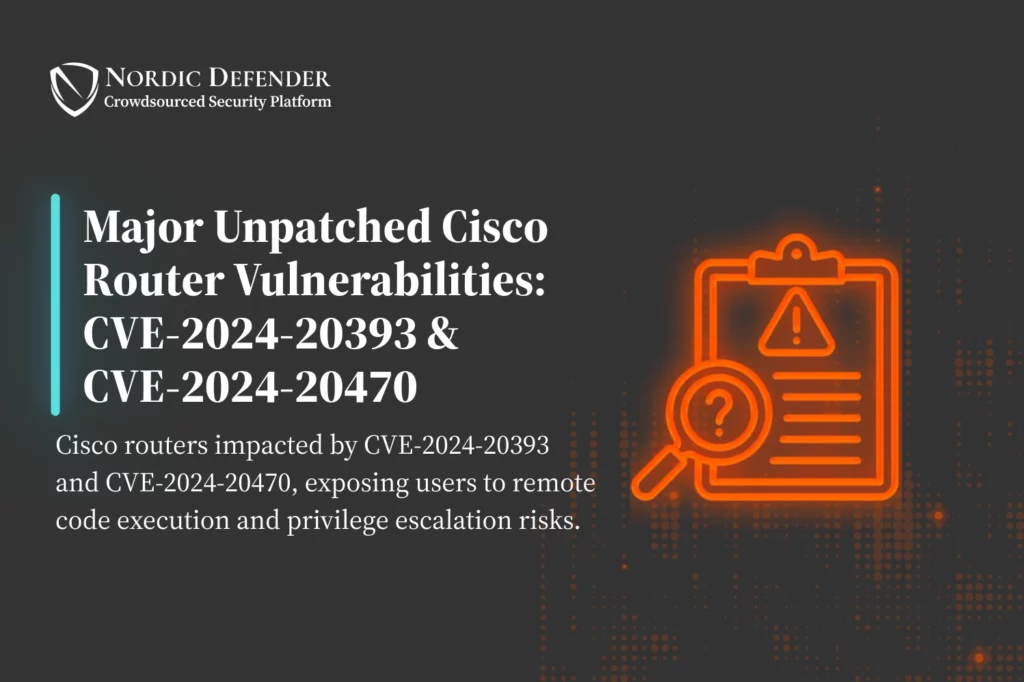In the latest wave of cybersecurity threats, significant vulnerabilities have been discovered in Cisco’s widely used RV340, RV340W, RV345, and RV345P routers. These vulnerabilities allow privilege escalation and remote code execution, putting both enterprises and individual users at high risk of severe cyberattacks. As a leading manufacturer of network equipment, Cisco’s products form the backbone of many small to medium-sized business (SMB) infrastructures, making this discovery especially alarming due to the scale of potential exploitation.
These vulnerabilities—CVE-2023-20129 (privilege escalation) and CVE-2023-20131 (remote code execution)—pose serious threats to the affected routers. They could allow attackers to compromise network security by taking control of routers, modifying configurations, exfiltrating sensitive data, or using the compromised network as a launchpad for further attacks.
Deep Dive into the Vulnerabilities
CVE-2024-20470: Privilege Escalation
Privilege escalation vulnerabilities occur when a user with limited permissions gains unauthorized access to higher-level privileges, in this case, administrative control. The CVE-2023-20129 vulnerability allows an attacker who already has basic access to a router to elevate their privileges to the admin level. Once an attacker gains this level of access, they can reconfigure the router, disable security features, install malicious software, and monitor or manipulate network traffic.
This can be especially dangerous in SMB environments where internal network users may be trusted by default. A compromised internal user, either malicious or unwitting, could exploit this vulnerability to gain full control of the network infrastructure, leading to data breaches or complete system compromise.
CVE-2024-20470: Remote Code Execution (RCE)
Remote code execution (RCE) is considered one of the most severe types of vulnerabilities because it allows attackers to run arbitrary code on a device, remotely. CVE-2023-20131 allows an unauthenticated attacker to execute malicious code on the router without needing direct physical access. By exploiting this vulnerability, an attacker could deploy malware, initiate denial-of-service attacks, or even exfiltrate sensitive information from connected systems.
The nature of RCE vulnerabilities often makes them a favorite target for cybercriminals looking to establish persistent access to a network. Once malicious code is executed, it can be incredibly challenging to detect or remove the threat without comprehensive monitoring and remediation efforts.
The Larger Risk Landscape: Why This Matters
The vulnerabilities identified in Cisco’s RV series routers highlight a larger issue within the cybersecurity landscape—network infrastructure devices are frequently targeted by advanced attackers. Unlike endpoint devices, routers and network equipment are often overlooked when it comes to patching and updating, leaving them exposed for longer periods.
While Cisco has acknowledged these vulnerabilities, no patches or firmware updates are available at the time of writing. This leaves businesses in a precarious situation where their network security is directly at risk, and attackers have a window of opportunity to exploit these flaws.
For many SMBs, Cisco’s RV series routers are not just a network device—they’re a critical part of daily operations, often controlling access to sensitive systems and data. An attacker who compromises the router could cause significant operational disruption, steal sensitive business data, or pivot into other parts of the network.
Temporary Mitigation: Workarounds Until a Patch Arrives
In response to these vulnerabilities, Cisco has recommended several temporary workarounds that users can implement until official patches are released. These include:
- Disable Web-Based Management Interfaces: One of the primary attack vectors is through the web management interface. Disabling this feature can reduce the risk of remote exploitation.
- Restrict Management Port Access: Limiting access to the management ports on the router by enforcing strict firewall rules can help mitigate attacks that rely on direct access.
- Enable Strong Authentication Mechanisms: Using strong authentication methods like multi-factor authentication (MFA) and rotating administrative passwords can further reduce the risk of privilege escalation.
- Monitor Network Traffic: Continuous monitoring of network traffic for unusual patterns can help detect exploitation attempts early. Look for signs of unauthorized login attempts or suspicious outbound connections.
While these steps provide some level of protection, they are by no means a comprehensive solution. The lack of available patches means businesses remain exposed, underscoring the need for constant vigilance and proactive measures.
The Strategic Importance of Router Security
The rise of sophisticated cyberattacks has made it increasingly clear that no part of an organization’s IT infrastructure is safe from exploitation, and routers play a critical role in safeguarding business networks. Insecure routers act as a weak link, potentially giving attackers the ability to bypass perimeter defenses. Compromised routers can be leveraged in a variety of attacks, including botnet deployment, man-in-the-middle attacks, and advanced persistent threats (APTs).
The impact of these attacks can be devastating. Consider the loss of business continuity, compromised customer data, and the potential financial losses from downtime or regulatory fines. In this case, the vulnerability in Cisco’s routers adds to the growing list of network equipment being targeted by cybercriminals.
What’s Next for Businesses?
For businesses using Cisco’s RV series routers, this is a crucial moment to evaluate their overall network security strategy. Businesses should:
- Conduct a Risk Assessment: Evaluate the impact that an attack on network infrastructure would have on operations. This should include identifying the most critical assets connected to the network.
- Implement Defense in Depth: Employ a multi-layered approach to security that includes network segmentation, robust firewall policies, endpoint protection, and intrusion detection systems (IDS).
- Stay Updated on Patches: Regularly check Cisco’s advisories and apply patches the moment they are available. Unpatched devices are a significant risk factor for long-term compromise.
- Consult with Cybersecurity Experts: With vulnerabilities as serious as these, engaging with cybersecurity experts can help organizations understand the full scope of the risk and implement tailored mitigation strategies.
At Nordic Defender, we offer advanced threat detection and mitigation services to help protect businesses from vulnerabilities like these. Our team can help assess your current network infrastructure and ensure it remains resilient to emerging threats. Stay ahead of the curve by investing in proactive security measures today.
